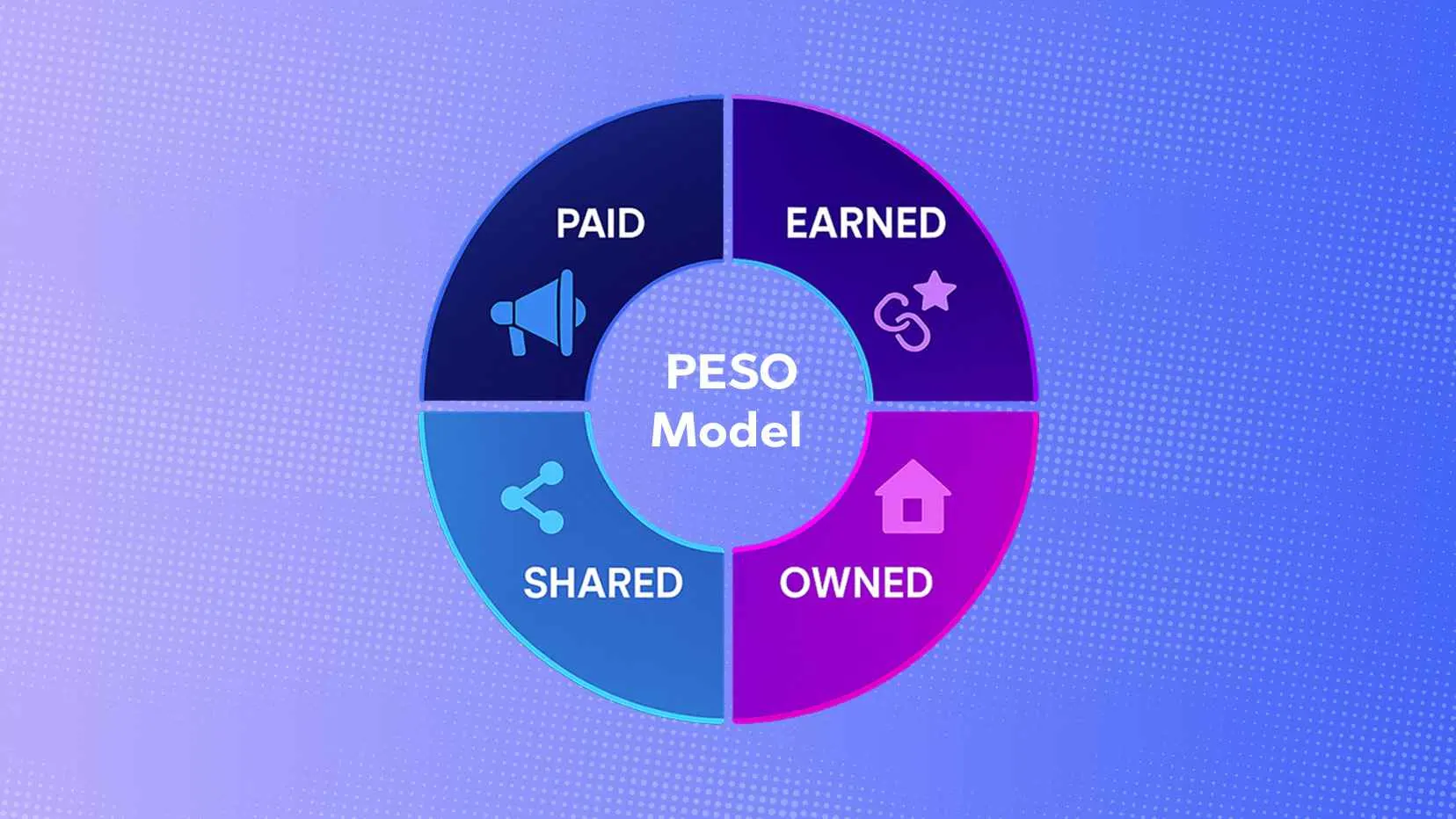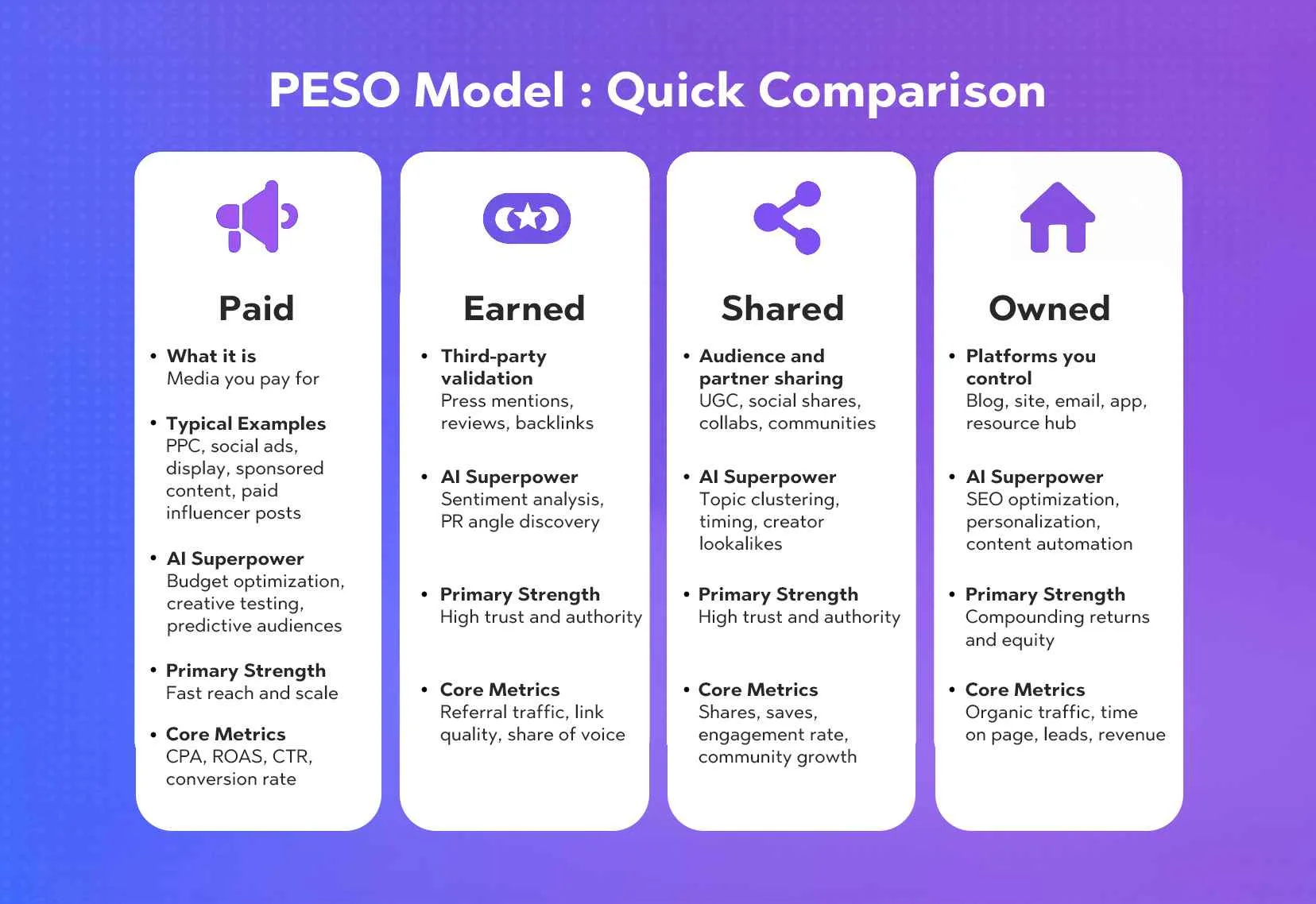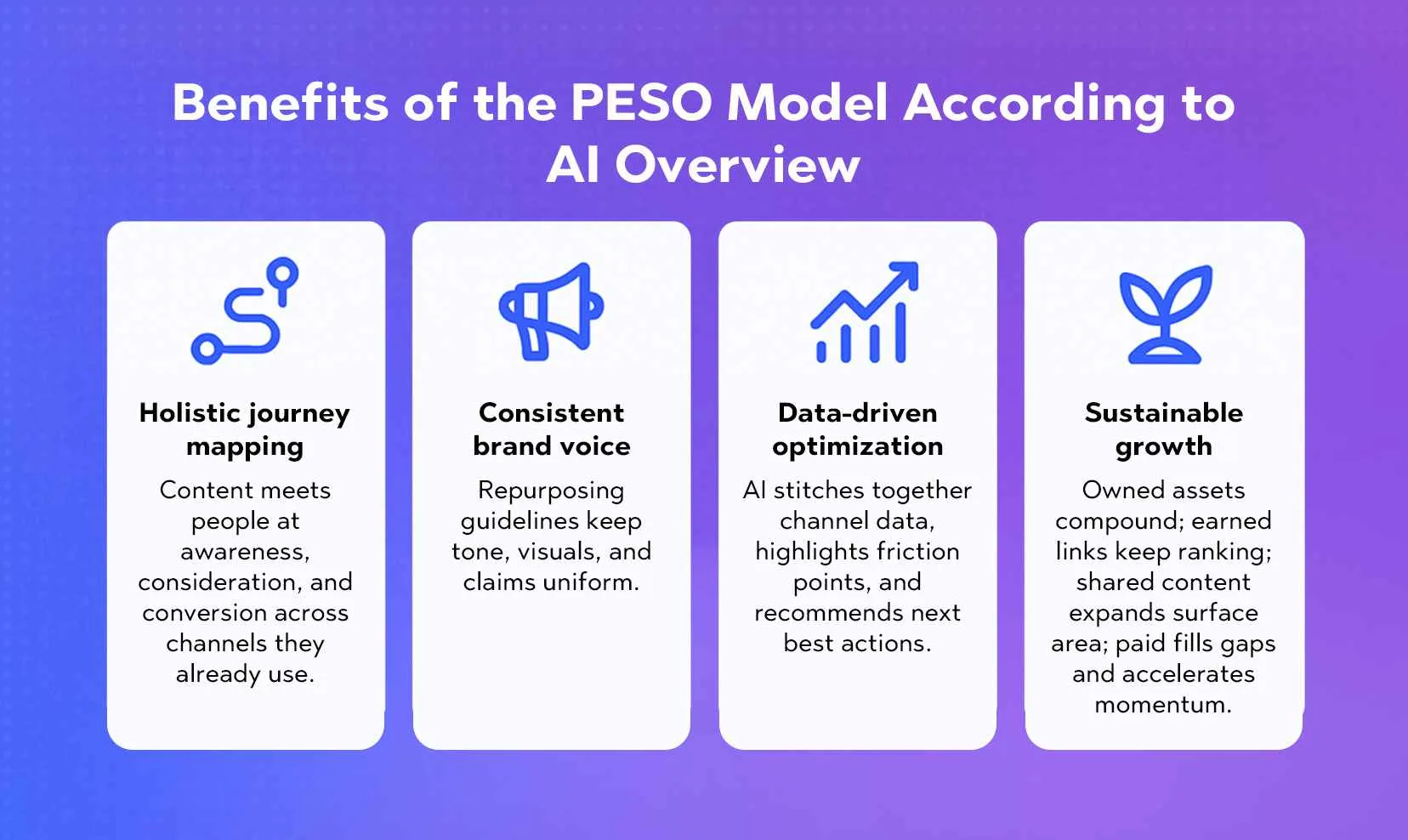Rahul Guleria
SEO Executive

Digital marketing moves fast. New platforms, shifting algorithms, and changing customer behaviour can make even solid plans feel shaky. That’s why marketers lean on clear frameworks to align teams, budgets, and goals.
Enter the PESO Model in Digital Marketing—a simple yet powerful way to blend channels and get work pulling in the same direction. It maps how content and promotion flow across Paid, Earned, Shared, and Owned media so campaigns scale with less guesswork and more impact.
Today’s AI-powered search experiences and AI Overviews increasingly reward integrated strategies over one-off tactics. When brands coordinate content across PESO channels, they show up more consistently, answer user intent better, and sustain visibility even as algorithms evolve.
Short definition: The PESO Model is a strategy framework that organizes marketing across Paid, Earned, Shared, and Owned media to build reach, trust, and measurable growth.
Expanded: PESO stands for Paid (you pay to reach), Earned (you earn coverage and links), Shared (audiences share and co-create), and Owned (you control the platform and content). In digital-first strategies, PESO turns scattered activities into a unified system that drives compounding results.
What it is: Promotional placements you pay for—search and social ads, display, programmatic, sponsored content, and influencer sponsorships.
Digital examples:
AI tools that help: Smart bidding, creative optimization, predictive audiences, and AI copy/image generation all reduce waste and speed testing. AI surfaces winning headlines, identifies micro-segments, and automates budget shifts toward high-ROAS ad sets.
Internal link prompt: Paid media refers to promotional efforts such as PPC campaigns, social media ads, and influencer sponsorships. If you want to dive deeper, here’s a detailed guide on what is paid media advertising is and how it works in modern marketing—visit our page on Paid media advertising.
What it is: Coverage or credibility you earn, not buy—think press mentions, reviews, backlinks, and organic influencer shoutouts.
Digital PR & SEO examples:
AI’s role: AI monitors brand mentions, performs sentiment analysis, and flags PR opportunities faster. It can cluster journalist interests, suggest angles, and score outreach lists. For SEO, AI helps spot link gaps, create briefs, and identify publishers likely to cite your research.
What it is: Social content distribution and community co-creation—your content gets shared by audiences, partners, and creators.
Examples:
AI-driven insights: AI clusters comments, DMs, and engagement into themes, revealing what resonates. It also predicts the best posting times, surfaces creator lookalikes, and recommends content tweaks to boost saves, shares, and watch time.
What it is: Channels you control—your website, blog, resource hub, landing pages, mobile app, and email/SMS newsletters.
Examples:
AI’s role: AI accelerates research, outlines, and drafts while preserving brand voice. It powers smart internal linking, on-page SEO improvements, and content recommendations. On the CRM side, AI personalizes emails and on-site experiences, lifting conversion rates without inflating costs.

Channel | What it is | Typical Example | AI Superpower | Primary Strength | Watchouts | Core Metrics |
|---|---|---|---|---|---|---|
Paid | Media you pay for | PPC, social ads, display, sponsored content, paid influencer posts | Budget optimization, creative testing, predictive audiences | Fast reach and scale | Cost creep, ad fatigue, tracking gaps | CPA, ROAS, CTR, conversion rate |
Earned | Third-party validation | Press mentions, reviews, backlinks, organic influencer shoutouts | Sentiment analysis, PR angle discovery | High trust and authority | Low control, time to win | Referral traffic, link quality, share of voice |
Shared | Audience and partner sharing | UGC, social shares, collabs, communities | Topic clustering, timing, and creator lookalikes | Community flywheel and virality | Platform dependence, moderation | Shares, saves, engagement rate, community growth |
Owned | Platforms you control | Blog, site, email, app, resource hub | SEO optimization, personalization, and content automation | Compounding returns and equity | Requires consistent quality, upkeep | Organic traffic, time on page, leads, revenue |
The PESO Model framework prevents siloed campaigns and keeps teams working from a single playbook. Instead of isolated efforts, it blends channels so one piece of content can create multiple outcomes: paid reach, earned credibility, shared amplification, and owned conversions.
Key advantages:
Start with an SEO-ready site, fast landing pages, a documented brand voice, and a content calendar. Create cornerstone pages that answer high-intent queries, plus conversion paths (lead magnets, demos, trials).
Promote those cornerstone assets across search and social. Use AI to test headlines, hooks, and creative variants. Retarget visitors with offers tailored to the funnel stage.
Package content for social: short videos, carousels, quote graphics, and UGC prompts. Empower employees and partners with ready-made snippets and incentives for co-posting.
Turn proprietary data, surveys, or tools into media-worthy stories. Pitch publications, collaborate with creators, and build digital PR campaigns aimed at quality backlinks and mentions.
Publish a research-backed blog on your site → promote it via Google/Meta ads → repurpose insights into short-form videos and infographics for social → trigger organic shares and community discussion → earn backlinks from industry blogs covering your findings → watch rankings and conversions climb.
A D2C wellness brand launched a new supplement line and built a PESO-driven plan over 90 days.
Numbers will vary by niche and spend, but the pattern holds: when the PESO Model marketing strategy connects content, community, credibility, and controlled distribution, results compound.

AI Overviews and AI-first search experiences reward substance, structure, and consistency. The PESO approach aligns with that reality.
Content meets people at awareness, consideration, and conversion across channels they already use.
Repurposing guidelines keep tone, visuals, and claims uniform.
AI stitches together channel data, highlights friction points, and recommends next best actions.
Owned assets compound; earned links keep ranking; shared content expands surface area; paid fills gaps and accelerates momentum.
The PESO Model in Digital Marketing turns scattered tactics into a balanced strategy. Paid delivers reach on demand. Earned builds authority. Shared fuels community and virality. Owned compounds are values you can control. Layer in AI to plan, produce, test, and personalize faster, and the framework becomes a growth engine rather than a checklist.
Start with owned foundations, amplify with paid, spark sharing, and pursue earned coverage. Keep the loop tight, the data flowing, and the message consistent. That’s how modern brands grow—steadily, predictably, and with less waste.
A: PESO stands for paid, earned, shared, and owned media. It’s a framework for building integrated campaigns that blend reach, trust, community, and conversion.
A: The PESO Model was popularized within the communications and PR industry as a way to organize modern media efforts across four pillars. It has since been widely adopted by marketers and digital teams for cross-channel planning.
A: It prevents siloed work, increases ROI, and creates consistency. Brands coordinate content and budgets across channels so each asset works harder—paid scales distribution, earned builds authority, shared expands social proof, and owned captures demand.
A: Start lean. Publish one high-quality guide (owned), run a small retargeting or search campaign (Paid), ask customers to share experiences (Shared), and pitch one or two local or niche publications with a useful data nugget (Earned). Grow each pillar as results and resources allow.
A: Traditional PESO relied on print, broadcast, and static placements. In digital, the same pillars operate with faster feedback loops, granular targeting, and measurable outcomes. AI now boosts each pillar—especially testing, personalization, and attribution.